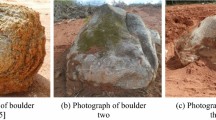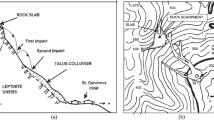Abstract
Overburden landslide is a common natural disaster worldwide. Many scholars study the stability of the overburden layer based on a linear, fold-line, or circular bedrock surface. They rarely systematically analyze the influence of irregular bedrock surfaces on instability characteristics of the overburden layer, because quantitatively characterizing an irregular bedrock surface is still problematic. This paper proposes a new method of random reconstruction of a bedrock surface based on the inverse discrete Fourier transform. And combined with the material point method (MPM), the whole process of slope instability is simulated and analyzed. Then the influence of the irregular bedrock surfaces on the instability characteristics of overburden landslides is studied quantitatively. The results indicate that the bedrock surface has a significant influence on instability characteristics of overburden landslide. The effect of bedrock surfaces represented by Fourier descriptor D1 shows duality, and that controlled by D2 can promote the stability of the overburden layer, and that reconstructed by D3 shows diversity. Furthermore, the influence laws of irregular bedrock surfaces on the instability characteristics of overburden landslides are proposed.









Similar content being viewed by others
References
Abe K, Nakamura S, Nakamura H, Shiomi K (2017) Numerical study on dynamic behavior of slope models including weak layers from deformation to failure using material point method. Soils Found 57(2):155–175
Abe K, Soga K, Bandara S (2014) Material point method for coupled hydromechanical problems. J Geotech Geoenviron 140(3):04013033
Azéma E, Radjai F, Saussine G (2009) Quasistatic rheology, force transmission and fabric properties of a packing of irregular polyhedral particles. Mech Mater 41(6):729–741
Bandara S, Ferrari A, Laloui L (2016) Modelling landslides in unsaturated slopes subjected to rainfall infiltration using material point method. Int J Numer Anal Methods Geomech 40(9):1358–1380
Bandara S, Soga K (2015) Coupling of soil deformation and pore fluid flow using material point method. Comput Geotech 63:199–214
Bardenhagen SG (2002) Energy conservation error in the material point method for solid mechanics. J Comput Phys 180(1):383–403
Bardenhagen SG, Brackbill JU, Sulsky D (2000) The material-point method for granular materials. Comput Methods Appl Mech Eng 187(3-4):529–541
Bardenhagen SG, Kober EM (2004) The generalized interpolation material point method. Comput Model Eng Sci 5(6):477–496
Bisohp AW (1955) The use of the slip circle in the stability analysis of earth slopes. Geotechnique 5:7–17
Cascini L, Cuomo S, Guida D (2008) Typical source areas of May 1998 flow-like mass movements in the Campania region, Southern Italy. Eng Geol 96(3-4):107–125
Cascini L, Cuomo S, Pastor M, Sacco C (2013) Modelling the post-failure stage of rainfall-induced landslides of the flow type. Can Geotech J 50(9):924–934
Cascini L, Cuomo S, Pastor M, Sorbino G, Piciullo L (2014) SPH run-out modelling of channelised landslides of the flow type. Geomorphology 214:502–513
Dai F, Lee CF, Wang S, Feng Y (1999) Stress–strain behaviour of a loosely compacted volcanic-derived soil and its significance to rainfall-induced fill slope failures. Eng Geol 53(3-4):359–370
Drucker DC, Prager W (1952) Soil mechanics and plastic analysis or limit design. Q Applied Math 10(2):157–165
Ehrlich R, Weinberg B (1970) An exact method for characterization of grain shape. J Sediment Res 40(1):205–212
Eichenberger J, Ferrari A, Laloui L (2013) Early warning thresholds for partially saturated slopes in volcanic ashes[J]. Comput Geotech 49:79–89
Esaki T, Jiang Y, Bhattarai TN, Nozaki A, Mizokami T (1998) Stability analysis and reinforcement system design in a progressively failed steep rock slope by the distinct element method. Int J Rock Mech Min Sci 4(35):664–666
Guglielmi Y, Cappa F (2010) Regional-scale relief evolution and large landslides: insights from geomechanical analyses in the Tinée Valley (southern French Alps). Geomorphology 117(1-2):121–129
Han Z, Su B, Li Y, Dou J, Wang W, Zhao L (2020) Modeling the progressive entrainment of bed sediment by viscous debris flows using the three-dimensional SC-HBP-SPH method. Water Res 182:116031
He X, Liang D, Bolton MD (2018) Run-out of cut-slope landslides: mesh-free simulations. Géotechnique 68(1):50–63
Hepdeniz K (2020) Using the analytic hierarchy process and frequency ratio methods for landslide susceptibility mapping in Isparta-Antalya highway (D-685), Turkey. Arab J Geosci 13(16):1–16
Higo Y, Oka F, Kimoto S, Morinaka Y, Goto Y, Chen Z (2010) A coupled MPM-FDM analysis method for multi-phase elasto-plastic soils. Soils Found 50(4):515–532
Hong H, You J, Bi X (2016) The Ludian earthquake of 3 August 2014. Geomat Nat Hazards Risk 7(2):450–457
Jassim I, Stolle D, Vermeer P (2013) Two-phase dynamic analysis by material point method. Int J Numer Anal Methods Geomech 37(15):2502–2522
Kuo YS, Tsai YJ, Chen YS, Shieh CL, Miyamoto K, Itoh T (2013) Movement of deep-seated rainfall-induced landslide at Hsiaolin Village during Typhoon Morakot. Landslides 10(2):191–202
Lee WL, Martinelli M, & Shieh CL (2019) Numerical analysis of the Shiaolin Landslide using material point method. 7th International Symposium on Geotechnical Safety and Risk 2019.
Li X, Xie Y, Gutierrez M (2018) A soft–rigid contact model of MPM for granular flow impact on retaining structures. Comput Part Mech 5(4):529–537
Li X, Xu X, Ran Y, Cui J, Xie Y, Xu F (2015) Compound fault rupture in the 2014 M s 6.5 Ludian, China, earthquake and significance to disaster mitigation. Seismol Res Lett 86(3):764–774
Li Z, Tao Z, Jiang Y, Lv Q, Darve F, He M (2019) Real-time monitoring and FEMLIP simulation of a rainfall-induced rockslide. Nat Hazards Earth Syst Sci 19(1):153–168
Liu H, Li X, Meng T, Liu Y (2020) Susceptibility mapping of damming landslide based on slope unit using frequency ratio model. Arab J Geosci 13(16):1–19
Ma S, Zhang X, Qiu XM (2009) Comparison study of MPM and SPH in modeling hypervelocity impact problems. Int J Impact Eng 36(2):272–282
McDougall S, Hungr O (2004) A model for the analysis of rapid landslide motion across three-dimensional terrain. Can Geotech J 41(6):1084–1097
Mollon G, Zhao J (2012) Fourier–Voronoi-based generation of realistic samples for discrete modelling of granular materials. Granul Matter 14(5):621–638
Mollon G, Zhao J (2013) Generating realistic 3D sand particles using Fourier descriptors. Granul Matter 15(1):95–108
Nairn JA (2003) Material point method calculations with explicit cracks. Comput Model Eng Sci 4(6):649–664
Pastor M, Haddad B, Sorbino G, Cuomo S, Drempetic V (2009) A depth-integrated, coupled SPH model for flow-like landslides and related phenomena. Int J Numer Anal Methods Geomech 33(2):143–172
Prime N, Dufour F, Darve F (2014) Solid–fluid transition modelling in geomaterials and application to a mudflow interacting with an obstacle. Int J Numer Anal Methods Geomech 38(13):1341–1361
Qiu G, Henke S, Grabe J (2011) Application of a Coupled Eulerian–Lagrangian approach on geomechanical problems involving large deformations. Comput Geotech 38(1):30–39
Shinoda M, Watanabe K, Sanagawa T, Abe K, Nakamura H, Kawai T, Nakamura S (2015) Dynamic behavior of slope models with various slope inclinations. Soils Found 55(1):127–142
Shirole D, Moormann C, Sharma KG (2017) A new continuum based model for the simulation of a seismically induced large-scale rockslide. Procedia Eng 173:1755–1762
Soga K, Alonso E, Yerro A, Kumar K, Bandara S (2016) Trends in large-deformation analysis of landslide mass movements with particular emphasis on the material point method. Géotechnique 66(3):248–273
Take WA, Bolton MD, Wong PCP, Yeung FJ (2004) Evaluation of landslide triggering mechanisms in model fill slopes. Landslides 1(3):173–184
Van Esch KJB (2012) Failure behaviour of bedrock and overburden landslides of the Peace River Valley near Fort St. John, British Columbia. Doctoral dissertation, University of British Columbia
Wu LZ, Shi JS, Xu Q (2017) The rainfall-induced Wulipo rockslide, China: a modified model for rockslide initiation. Environ Earth Sci 76(14):1–11
Wu T, Zhou C, Jiang N, Xia Y, Zhang Y (2020) Stability analysis for high-steep slope subjected to repeated blasting vibration. Arab J Geosci 13(17):1–12
Yang W, Xia X, Zhao G, Ji Y, Shen D (2011) Overburden failure and the prevention of water and sand inrush during coal mining under thin bedrock. Mining Sci Technol (China) 21(5):733–736
Yerro A, Alonso EE, Pinyol NM (2016) Run-out of landslides in brittle soils. Comput Geotech 80:427–439
Zhao A, FENG C, LI, S., AI, C., & LIU, Y. (2012) Experimental research on seismic failure mode and supporting for slope of bedrock and overburden layer. Rock Soil Mech 33(2):515–523
Zhao LH, Dongliang H, Han-Cheng D, Shuaihao Z, Dejian L (2017) Reconstruction of granular railway ballast based on inverse discrete Fourier transform method. Granul Matter 19(4):1–17
Zhang X, Chen Z, & Liu Y (2016) The material point method: a continuum-based particle method for extreme loading cases. Academic Press.
Funding
This study was financially supported by the National Natural Science Foundation of China (Nos. 51878668 and 51978666), Science and Technology Project of Guizhou Provincial Department of Transportation (No. 2018-123-040), Key Projects of Science and Technology Support Plan of Guizhou Provincial Department of Science and Technology (No. [2018]2815), and the Key Project of Science and Technology of Jiangxi Provincial Department of Transportation (No. 2019C0011). All financial supports were greatly appreciated.
Author information
Authors and Affiliations
Corresponding author
Ethics declarations
Conflict of interest
The authors declare no competing interests.
Additional information
Responsible editor: Zeynal Abiddin Erguler
Rights and permissions
About this article
Cite this article
Qiao, N., Zhao, LH., Wang, X. et al. Influence analysis of irregular bedrock surface on failure characteristics of bedrock and overburden layer slope by material point method. Arab J Geosci 14, 2002 (2021). https://doi.org/10.1007/s12517-021-08363-x
Received:
Accepted:
Published:
DOI: https://doi.org/10.1007/s12517-021-08363-x




